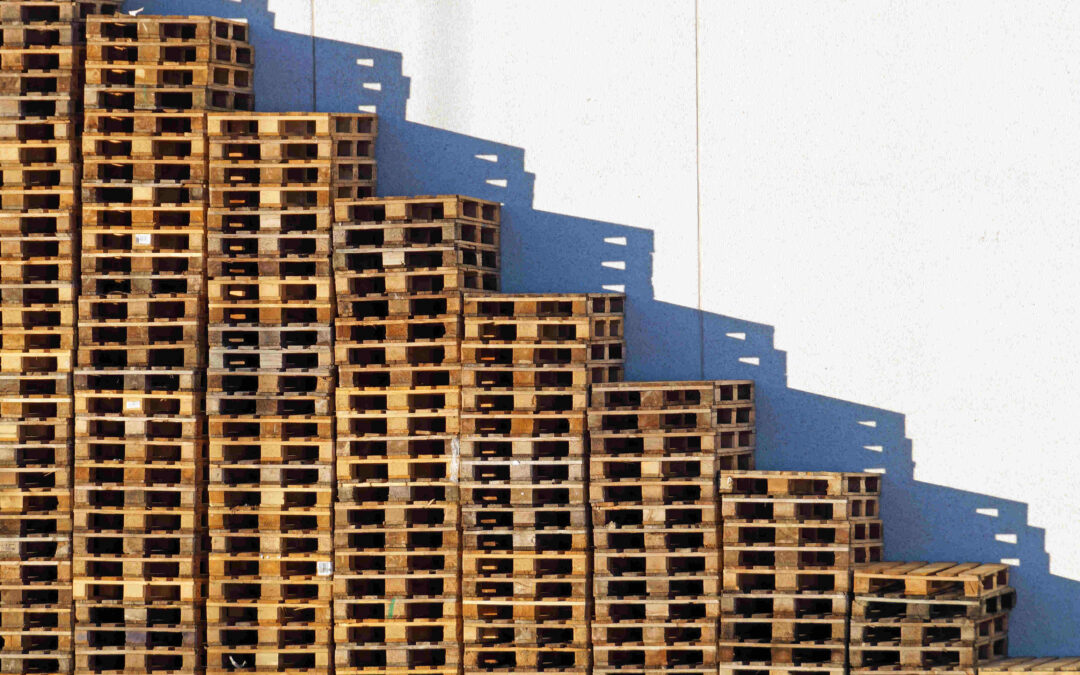In most production lines, the final production stage is the palletising of goods. What is this process, and what are its benefits?
Table of contents:
What is palletisation?
Palletisation is the process of placing goods on a pallet or other type of bulk packaging. Until recently, palletising was carried out manually by employees. Nowadays, especially in large companies or warehouses, automatic palletising, usually carried out by palletising robots, is beginning to dominate.
Palletising is the final part of almost every production process. Palletising prepares finished products for storage and further transport. Therefore, the whole operation must be carried out in such a way that the packaged goods are adequately protected against damage or any other type of event that could negatively affect their quality.
Robotic palletising systems are beginning to dominate the market because stacking goods on a pallet or in bulk packaging involves workers performing repetitive movements over long periods. This type of operation is always ripe for automation, firstly because it can be done quickly and easily. Secondly, it allows workers previously involved in packing to be reassigned to other, more demanding tasks.
Manual palletising carries a risk of error because human movements are never as precise as a robot’s. Incorrect positioning of goods on the pallet can easily lead to damage and even hazards, such as goods falling off the pallet.
Manual packing, even seemingly light goods, is highly tiring for workers, both physically and mentally. Repetitive movements quickly lead to fatigue and lifting even light packages becomes extremely dangerous for the back and joints when this type of activity is carried out several hundred times a day. For the sake of their own health, packers need to take frequent breaks.
Automatic palletising – advantages
The solution to all of the above problems with manual palletising is an automated system. Admittedly, the initial cost of purchasing an industrial robot to pack goods may seem high. Still, for larger manufacturing companies and warehouses, it is an investment that will pay for itself very quickly.
So what are the main benefits of automated palletising? Following what we said earlier in the text, it is unquestionably less hazardous to workers’ health. Repeatedly performing the same movements and handling even the heaviest goods does not affect the industrial robot at all. Nor does the palletising robot need the breaks necessary for the health of the workers.
Automated palletising can also be used in conditions that are difficult for humans to work in. For example, in a dusty room where palletising takes place, there may be inadequate lighting or even no light. Of course, sometimes the palletising system breaks down, but this happens much less frequently than, for example, a worker falling ill.
The use of industrial robots also, of course, greatly increases palletising efficiency. Properly protected by a fence, the machine can carry out movements at speed unattainable by humans. Thanks to its high lifting capacity, it can also stack an entire layer of pallets in a single movement, significantly increasing the packing process’s speed.
Palletising system – which one to choose?
You already know what palletising is and the benefits of automating it. But how do you choose the right type of palletiser best suited to placing a particular type of goods on a pallet or in bulk packaging?
Before deciding on a particular solution, it is important to thoroughly analyse the type of goods to be palletised. What does this mean exactly? Consider the shape of the packages, their dimensions and their weight. Also, very important are the target capacities of the whole line and the area where the palletiser can be installed. All these factors will help you choose the right palletising robot and indicate how its gripper should be designed.
When it comes to palletising workstations, classic articulated robots are the most commonly used. This is because their main advantages are their long reach, lifting capacity and versatility. With the right gripper, an articulated robot can handle almost any type of goods, which is why this type of equipment is used in almost every industry.
Another common application for automatic palletising is the use of a Cartesian robot. The machine’s components can be easily adapted to the dimensions and weight of different products, which gives a great deal of freedom in the design of this type of equipment. Building a Cartesian system with a gripper is generally cheaper than buying an articulated robot, but this type of machine does not offer the same freedom of movement as a robot. The Cartesian system is ideal for palletising products packed in cartons and boxes.
In recent years, collaborative robots have been increasingly used for palletising. This equipment is ideal for stacking smaller, lighter goods with a lower capacity. They can work alongside people, and the lack of special enclosures required for standard robots means that palletising robots can be installed wherever space is at a premium.
Palletisation of goods. Summary
In summary, the final step in almost every production process is palletising. What is this process and what does it involve? The name describes placing finished products on pallets or in bulk packaging. Until recently, especially for smaller companies, this was done by hand. Today, automated palletising is becoming increasingly popular.
There are many advantages to automating the palletising process. Using a robot or Cartesian system increases the efficiency of the entire operation, relieving workers who find repetitive movements and moving boxes from place to place monotonous and harmful to their health. Automated palletising also allows for greater precision in placing goods on pallets.
Are you considering automating the packing process in your company, but not sure what type of solution will meet your needs? Use our contact form to request a quote. Unilogo’s team of experts will help you find the best solution for your product.


